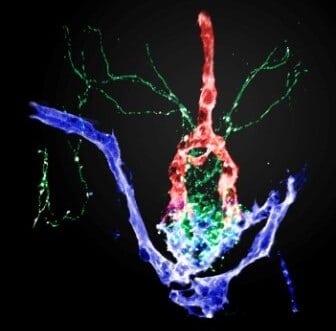Scientists from the Weizmann Institute of Science how exactly a vital area in the brain is built, through which the brain transmits certain biochemical commands to the blood circulation, and from there to the whole body. Their findings also reveal a new and surprising role for the hormone oxytocin, which is known as the "love hormone".

The common saying that "it's all in the head" is a fairly accurate description of the functioning of the human body: a significant part of the body's chemistry is controlled by the brain, starting with blood pressure and ending with appetite and metabolism. In a study recently published in the scientific journal Developmental Cell, a group of scientists led by Dr. Gil Lebkowitz from the Weizmann Institute of Science discovered exactly how a vital area in the brain is built, through which the brain transmits certain biochemical commands to the bloodstream, and from there to the entire body. Their findings also reveal a new and surprising role for the hormone oxytocin, which is known as the "love hormone".
This area, called the neurohypophysis, is at the bottom of the base of the brain, and is an interface for the passage of information from the nerve fibers to the blood vessels. In this place, part of the important dialogue between the brain and the body takes place: the nerve cells secrete into the blood the hormones that control a number of central processes, including, among others, the control of the fluid balance in the body, and the contractions of the uterus during childbirth.
The neurohypophysis has been studied for over a century. Now, using new genetic tools developed by Weizmann Institute scientists, a renewed examination of its three-dimensional structure has become possible, and the molecular processes leading to the formation of this region during embryonic development have been clarified.
The human neurohypophysis consists of tens of thousands of cells, so the scientists conducted the study in live embryos of zebrafish, and were able to observe through a microscope - and in real time - how the neurohypophysis of the fish is formed. These fish are a particularly successful model for studying the brains of vertebrates because their brains are simpler, their bodies are transparent, and genetic changes can be made in them relatively easily. However, thanks to the fact that the neurohypophysis is structured similarly in all vertebrates, the findings are also valid for humans. The research was carried out in the laboratory of Dr. Lebkowitz from the Department of Molecular Biology of the Cell by research student Amos Gutnik and Dr. Jeanne Lachman, in collaboration with scientists from Australia, Switzerland and the USA.
The research revealed a new and surprising role for the hormone oxytocin. This hormone has been nicknamed the "love hormone", because in addition to its contribution to appetite control and reproductive functions in women, such as breastfeeding, it also contributes to maternal feelings and a sense of closeness between spouses. The institute's scientists showed that oxytocin, one of the two main hormones secreted by the neuro-hypophysis during adulthood, participates in the development of this brain area already in the embryonic stage. In the fetus, the oxytocin, secreted by nerve cells, helps to create new blood vessels. "Essentially, this hormonal messenger helps to build the pipes, through which its own messages will be transmitted in the future," says Dr. Lebkowitz. The journal Developmental Cell published a trailer on these findings under the title "The love hormone attracts a life partner."
These findings are an important achievement for basic science because they shed light on very fundamental processes in the brain, but in the future they may also have a contribution to the treatment of diseases: the neurohypophysis is one of the few areas of the brain that undergoes rehabilitation after an injury. Therefore, understanding how it is formed may in the future develop methods to restore other damaged areas of the brain.
for the scientific article

2 תגובות
Funny, but just the other day I saw the talk on the TED website.
I was very interested so I tried to delve deeper.
I could not find access to the article that is not paid for, but the responses to the lecture showed great skepticism of the findings.
The same Paul Zack, how much basis does his research really have?
relevant:
http://www.youtube.com/watch?v=rFAdlU2ETjU
There's nothing like a little touch here and there to release oxytocin on dates and even at work.
It works, a more personal connection is really formed.